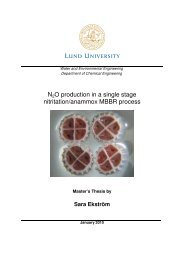Bättre EU-regler för en giftfri miljö - Kemikalieinspektionen
Bättre EU-regler för en giftfri miljö - Kemikalieinspektionen
Bättre EU-regler för en giftfri miljö - Kemikalieinspektionen
You also want an ePaper? Increase the reach of your titles
YUMPU automatically turns print PDFs into web optimized ePapers that Google loves.
Chemicals Ag<strong>en</strong>cy and the Swedish Environm<strong>en</strong>tal Protection Ag<strong>en</strong>cy int<strong>en</strong>d to take the<br />
initiative regarding an analysis of the following questions:<br />
• Which policy instrum<strong>en</strong>ts and measures are most effective and suitable in order to<br />
regulate hazardous substances in a life-cycle perspective?<br />
• Which policy instrum<strong>en</strong>ts and measures are most suitable for use in achieving synergies<br />
betwe<strong>en</strong> non-toxic and resource-effici<strong>en</strong>t?<br />
• How do we <strong>en</strong>sure that decisions in the various sets of rules work in the same direction?<br />
Such an analysis is an important basis for the work aimed at a strategy which improves the<br />
coordination betwe<strong>en</strong> waste, chemicals and product legislation. Results of the analyses are<br />
needed in order to be able to bring about better coordination betwe<strong>en</strong> the chemicals, products<br />
and waste rules. Work can be initiated nationally in order to be utilised and developed later at<br />
<strong>EU</strong> level. The consideration of a number of matters can be included in such an analysis, such<br />
as<br />
• increasing the number of hazardous substances in the <strong>EU</strong>’s existing rules regarding<br />
producer responsibility,<br />
• expanding <strong>EU</strong> rules on producer responsibility to include more product types,<br />
• analysing how the <strong>EU</strong>’s rules governing wh<strong>en</strong> waste ceases to be waste (i.e. criteria for<br />
End of Waste) can take account of the levels of hazardous substances in waste.<br />
Swed<strong>en</strong> should, in our opinion, seek to str<strong>en</strong>gth<strong>en</strong> <strong>EU</strong> rules governing waste classification<br />
with regard to substances of very high concern, clarifying that POPs and PBT-containing<br />
waste would be classified as hazardous waste. There is reason to review how recycled<br />
substances are handled with regard to the registration and information requirem<strong>en</strong>ts in<br />
REACH and, finally, it is important to adapt the information in REACH so that it is more<br />
user-fri<strong>en</strong>dly and to communicate the information to the waste sector.<br />
Safe destruction of substances of very high concern (Chapter 8.9)<br />
There is a global lack of adequate capacity for the destruction of substances of very high<br />
concern. This constitutes an obstacle to the work on persist<strong>en</strong>t organic pollutants (POPs). The<br />
lack is an obstacle both to good compliance with existing rules and to the willingness of<br />
countries and parties to ext<strong>en</strong>d the rules to cover more POPs. Swed<strong>en</strong> should <strong>en</strong>courage an<br />
increased destruction capacity globally, and the Swedish EPA could initiate an analysis of the<br />
options for developing such capacity. The results of the analysis could th<strong>en</strong> be used as the<br />
Swedish position in various international negotiations. The analysis can, for example, include:<br />
• working towards achieving that all parties to the Basel and Stockholm conv<strong>en</strong>tions have<br />
access to incineration capacity for the destruction of hazardous waste, including POPs<br />
waste at high temperatures;<br />
• possibilities for following up at <strong>EU</strong> level how the member states have implem<strong>en</strong>ted<br />
Article 16 of the Waste Directive regarding working towards suitable treatm<strong>en</strong>t capacity<br />
being available in the <strong>EU</strong>;<br />
• complem<strong>en</strong>ting the limit values for POPs in waste with e.g. guidance in order to facilitate<br />
an agreem<strong>en</strong>t on safe handling of waste containing new POPs substances<br />
Environm<strong>en</strong>tal monitoring (Chapter 8.10)<br />
In the <strong>EU</strong> there is a lack of instrum<strong>en</strong>ts which can assist with continuous monitoring relating<br />
to hazardous substances in the <strong>en</strong>vironm<strong>en</strong>t. There is, however, reason to develop such a<br />
common system, not least for the legislation for control of substances to be uniform. This is<br />
26















